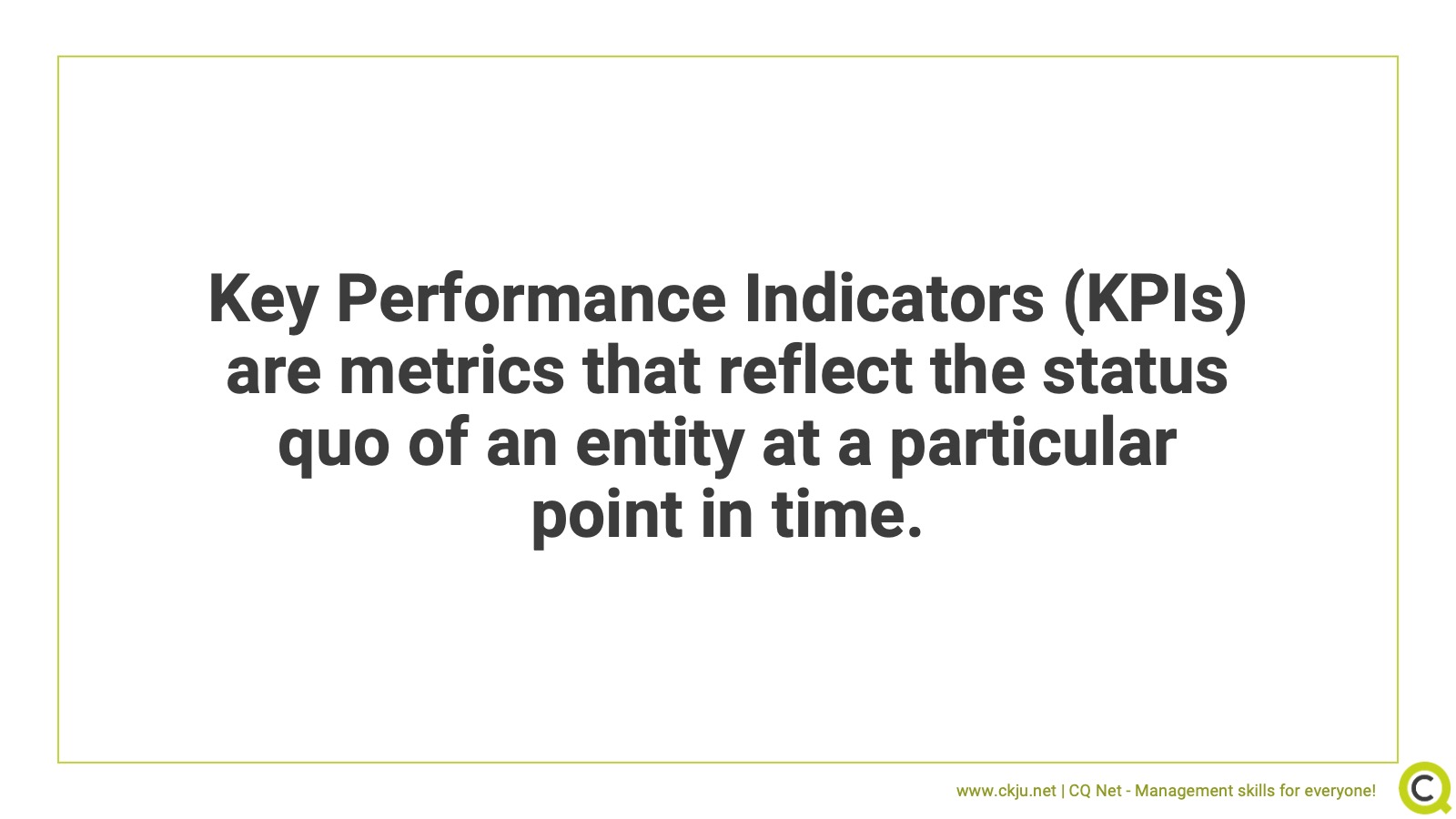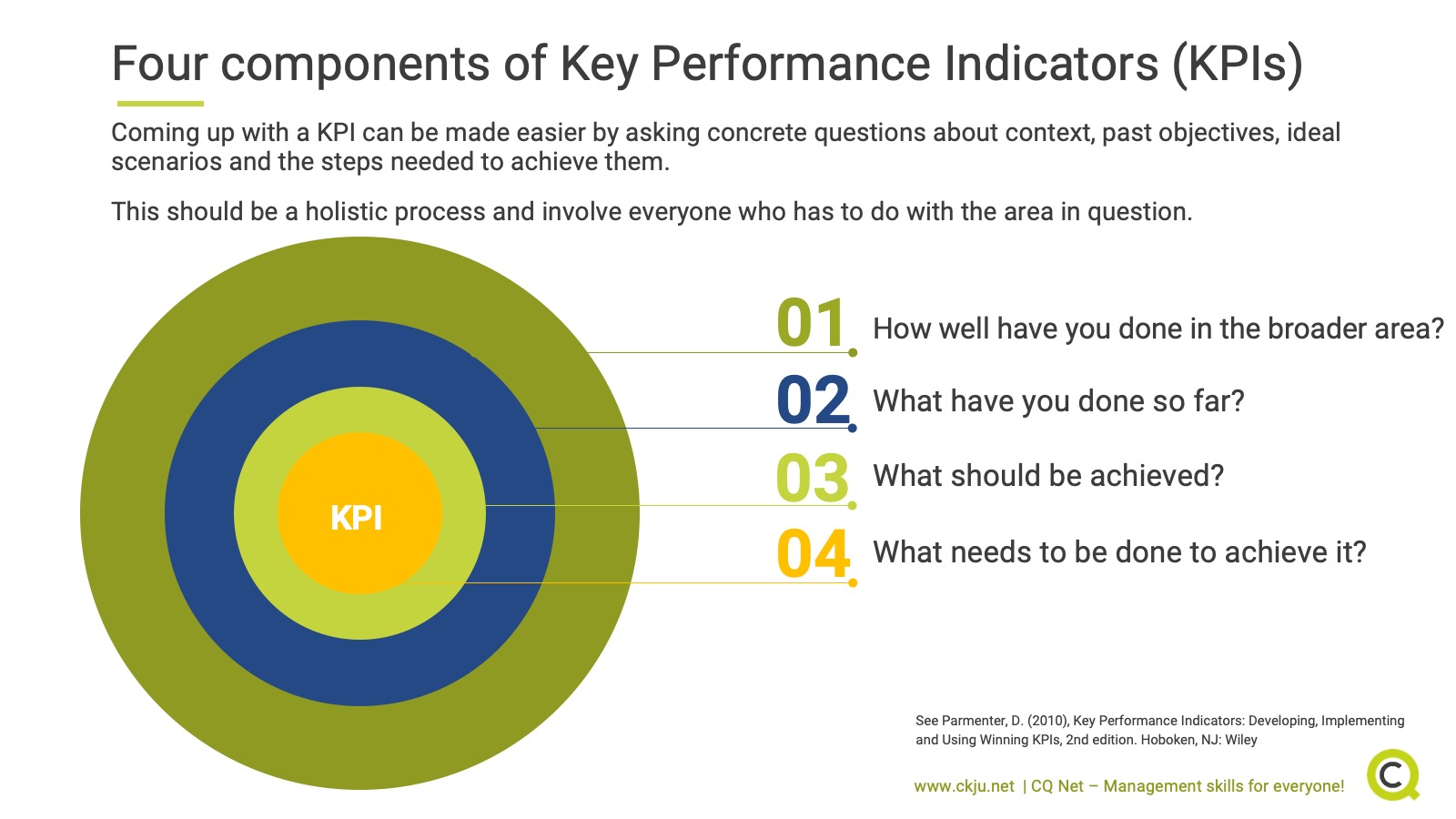- All Management Learning Resources
- key performance indicators

Why should you care about Key Performance Indicators?
A popular saying in organizations is “what gets measured gets done“. Key performance indicators (KPIs) are the tool of choice for any professional: they are metrics used when devising strategies, when measuring performance, and when setting goals. They help decision-making by bringing objectives into the foreground and by providing a framework for analysis. KPIs are one of several frameworks helping organizations progress into the desired direction.
Contents
- Why should you care about Key Performance Indicators?
- What is a Key Performance Indicator (KPI)?
- What are common examples of Key Performance Indicators (KPIs)?
- What are the benefits of Key Performance Indicators (KPIs)?
- What are the shortcomings of Key Performance Indicators (KPIs)?
- How to use Key Performance Indicators (KPIs) in practice
- A case example: accidents in organizations
- KPIs link goals with objectives and strategies
- Alternative concepts to key performance indicators
- Conclusion
- Key recommendations for professionals
- References and further reading
What is a Key Performance Indicator (KPI)?
In organizations, it is crucial to have a good understanding of what is going on at any point in time. This can take many forms and there are countless approaches to do this. The implementation of so-called KPIs – key performance indicators - is one of them.
KPIs can generally be defined as “specific measures of the performance of an individual, team or department.” (Law, 2016). They reflect critical success or failure that can be used to understand current performance and better prepare for future performance.
KPIs are usually a metric (number, percentage, scale, etc.) reflecting that status of an entity in a point in time. An entity in this context can be anything starting from an organisation, a process, a piece of machinery or any other type of system.
In other words, a KPI quantifies the status quo of a particular thing. It is a metric that helps identify, measure, report and manage key developments. In business, this is incredibly useful: KPIs reduce the complexity of many different processes and boil down what is happening into a single number. This can shed light on past developments and future directions.
What are common examples of Key Performance Indicators (KPIs)?
KPIs have an extremely long history in practical use. Below are some examples of how they have been used in various settings:
- KPIs in finance: measuring return on sales, return on investments
- KPIs in operations: efficiency rations, lead time, parts per day
- KPIs in healthcare: average days of hospitalization, treatment costs per patient, mortality rate per hospital
- KPIs in banking: number of assets, number of loans, customer retention
- KPIs in retail: expected return, customer satisfaction, sales per store
- KPIs in teamwork: projects completed, clients satisfied
- KPIs in corporate social responsibility: stakeholder cooperations yielded, money donated
KPIs only make sense when considered in their context. While a productivity KPI should be high, healthcare KPIs like mortality rate should be low. Therefore, KPIs are not to be taken at point-blank value. In addition, not all KPIs are born equal. Whoever does business with a KPI must have in-depth understanding of the organization: the person must be able to “differentiate more important strategy-driven metrics from the plain vanilla metrics” (Bauer, 2004).
What are the benefits of Key Performance Indicators (KPIs)?
KPIs have been used in management for a long time. The many benefits associated with using KPIs are one of the reasons why they are so popular in the first place. What are the benefits associated with KPIs and are they applicable to every setting?
KPIs help quickly understand complex statuses
There are two things many organizations can probably agree on: efficiency is important, and time is money. KPIs are incredibly useful for assessing the many intertwining processes and activities going on in organizations. They can help save time and increase efficiency in management.
KPIs can be used to formulate goals and to measure their implementation
Goal setting is an important management tool. Goals only make sense when their implementation and progress can also be measured. This is why KPIs are the tool of choice for goal-setting and progress monitoring: they help define the steps that are needed to reach particular goals and are ideally embedded into broader strategic considerations.
KPIs increase efficiency in communication
Communication takes time, particularly in complex and unpredictable situations. In a VUCA world, communication is key to ensuring quick adaptation to new circumstances. KPIs can boost efficiency in communication when a sound (team) mental model is in place. In other words, when groups share understandings and visions of how to achieve certain tasks, agreeing on KPIs can boost teamwork, morale and output.
KPIs provide a sound basis for decision-making
One of the biggest issues in decision-making is bias. This is particularly evident in the area of management. When properly formulated, KPIs can help minimise bias and focus on facts and figures. This form of evidence-based management helps increase the quality of decisions and reduces uncertainty by managing risks.
KPIs are easy to formulate and devise
KPIs are not complex in themselves – in fact they are easy to create and to “set up”. A brief analysis of the situation at hand is the starting point to creating a key performance indicator.
What are the shortcomings of Key Performance Indicators (KPIs)?
There are no magic management tools that are able to solve all problems. In fact, it is common to assume that once a KPI has been identified, define and formalized, the KPI battle is won (Bauer, 2005). This is not the case. As with many other tools, also KPIs have shortcoming which should be mentioned:
KPIs tend to oversimplify complex issues
The main mechanism behind using a KPI is the aggregation of complex information into one number that reflects the entity’s status. While this simplifies complexity, it can also lead to the loss of important information. This is crucial to be aware of in decision-making.
KPIs are easily faked
KPIs reflect the status of an entity on a high level – their use is usually not questioned and numbers stand as they stand. This makes KPIs an easy target for manipulation.
KPIs can be misinterpreted
Managing organizations and organizational processes using key performance indicators requires a well-aligned team or group within the organization who all share the same understanding of the KPI. If this is not the case, misinterpretations and misunderstandings can take place, which not only hamper decision-making efforts but can also lead to team conflict.
One KPI is usually not sufficient to understand the whole entity
While one of the advantages of KPIs is simplicity, there are two sides to this: simplicity may lead people to believe that KPIs are also easy to understand and analyse, and that it is consequently also easy to draw conclusions form KPIs. This is not the case. Organizations are usually much more complex than one single KPI can grasp. Consequently, it is important to look at a set of KPIs and to consider their shortcomings.
How to use Key Performance Indicators (KPIs) in practice
When considering the body of academic research, there are hundreds of definitions and types of KPIs that have been identified over the years.
One common distinction is presented by Parmenter (2010): there are four types of measurement useful for organizations, which can be conceived in combination to make up a KPI. These should be considered in chronological order and include:
- Key result indicators – how well have you done?
- Result indicators – what have you done?
- Performance indicators – what shall be done?
- Performance increase – KPIs indicate what needs to be done
According to Parmenter, these indicators can be conceptualised like an onion. To be able to use a KPI effectively, it is important to consider the surrounding components: what are the key results? Based on these results, what has already happened? Based on what has happened, what should still happen? Answering these questions paves the way to understanding the actual KPI, which indicates what needs to be done to achieve the anticipated result based on considerations about results and performance.
A case example: accidents in organizations
Let us assume you are part of an organization that is struggling to understand why accidents happen. To solve the problem, someone suggests the use of KPIs measure and to then improve the situation. How would go about this? Let us consider how using a KPI could work:
Contextualise the KPI to understand it
Safety in organizations does not stand alone. Rather, safety considerations are embedded into a broader context. The context considers what is the status of the organization (how does the organization work? Which processes are in place?) as well as the culture surrounding it. Safety culture is an important aspect to any considerations about workplace safety. Without a culture in which people are aware of safety protocols and their importance, safety rules and regulations may not be as effective.
Furthermore, consider the onion: what has already been done in this area? Have there already been initiatives to improve safety culture and, by extension, to reduce accidents? What does this mean? The problems already identified once and the results yielded can shed light on new or old issues that require attention.
Understand what you are measuring
After contextualising the KPI, key components should be identified of what should be measured. While it does make sense to use more than one KPI, too many are not beneficial either. The KPIs in the context of safety in an organization could include: how many accidents occur in department x? How many accidents occur in the work process x? How many accidents happen in the mornings/afternoons? How many accidents have to do with negligence? How many KPIs have to do with structural deficits? However, these are only some of several ways to approach the goal of minimizing accidents.
Assuming it is already clear that safety culture is the issue, this needs to be tackled first. A KPI could include, how many supervisor meetings on safety have been conducted?
Formalise the KPI and monitor progress
KPIs are tools to measure a particular status quo in an organization. However, they can very well frame and determine the action that will be taken. Therefore, it is important to ensure that devising and monitoring KPIs is a collaborative process that builds on consensus. KPIs are not universal solutions to problems so it is important to include all people involved in the topic (at least) and to get management approval, as what you find may very well alter processes.
Draw conclusions
Based on what you find in the different KPIs you have defined over a certain period of time, certain conclusions can be drawn. These conclusions are not linear – rather they emerge from careful analysis of the different insights. Again, this is a collaborative process that does not yield universal responses. While a KPI depicting many accidents happen in the morning could mean people are more tired in the morning, it could also mean that the team composition at that time has a negative effect on accidents, or that when machines are refilled with resources these are faulty.
Therefore, it is key to remain understanding, to acknowledge all opinions, and to draw conclusions that do not disadvantage anyone. Also, constantly referring to the overall goal is not beneficial. Reaching the goal (reducing accidents) consists of multiple steps which are likely not to be reached by a single round of using and analysing KPIs.
Rinse and repeat
As previously mentioned, KPIs depict certain points in time. This means that with time, the same KPI might lead different results. Using a KPI strategy is therefore a process that can be repeated indefinite times with the same or with different metrics. Change is not a one-stop process but occurs over time. This is good, as considering multiple facets of organizations at multiple times with many people can have a positive effect on organizational culture as a whole and improve communication.
KPIs link goals with objectives and strategies
Based on the above, It is safe to point out that KPIs should ideally be linked to goals, goals should link to objectives, and objectives should inform broader strategies (Griffin, 2004).In other words, the goal in this situation is to reduce accidents. First, the objective to achieve this goal is to understand processes and to understand the complexity of accidents in the organization (context). Then, these objectives should inform broader strategies which get the organization closer to achieving the goal – step by step and over time. For example, strategies could include implementing collaborative decision-making processes, conducting performance management, improving communication culture, or switching leadership.
Alternative concepts to key performance indicators
As previously mentioned, KPIs are one of countless management tools that help establish metrics for organizations. Not all organizations have the same needs and for some, KPIs may simply have too many shortcomings.
There are two further conceptual models that work similarly to KPIs and measure on metrics for performance: Objectives and Key Results (OKRs) and Key Result Areas (KRAs). In some cases, it makes sense to use the three models together as they complement each other.
Objectives and Key Results (OKRs), Key Result Areas (KRAs) and KPIs do not exclude each other
OKRs can be used at various levels of an organization and can help formulate desired goals and outcomes (objectives) as well as targets (measurable results) that lead to these goals. OKRs are commonly used in the agile context and work in sprints of 30-90 days. They are reviewed and adapted frequently.
KRAs on the other hand are crucial areas or strategic priorities that matter to organizations. For some, KRAs are the very areas in which KPIs take root: for example, if a hospital cares about reducing mortality, the corresponding KPI is a reduced number of deaths per year. KRAs are difficult to define but make it easier to relate indicators to strategic goals.
Conclusion
KPIs are useful and help set the bar on what an organization wants to achieve. Indicators that help measure crucial performance components help understand possibilities and limitations, and can be tied into broader strategic consierations. However, also KPIs have shortcomings despite their popularity.
Overall, like with any other tool, they are to be considered with caution and should not be taken for point-blank value. Instead, they can be viewed as useful reflections of various points in organizational settings, which provide valuable insights. Of course, what is made of these insights and how they are used is key: KPIs should be devised and reviewed collaboratively and linked to to the internal and external context in which they are embedded. In addition, KPIs are not directly linked to goals but rather inform strategies to meet objectives that work towards a goal.
Key recommendations for professionals
- Not all KPIs are the same: they mirror certain aspects of an entity (process, organization, system, etc.) in a certain point in time
- KPIs can help inform measurement, reporting and management of key developments to achieve particular goals
- KPIs can be used in all aspects of an organization but cannot solve all problems or provide universal solutions
- KPIs should be developed together with those involved
- KPIs should be embedded into contexts, therefore they must be treated as a dynamic process rather than a single, linear answer to a question
References and further reading
Bauer, K. (2004). The Power of metrics - KPIs: Not all metrics are created equal. DM Review, 14 (12), 1-3.
Bauer, K. (2005). KPIs: Avoiding the Threshold McGuffins. DM Review, 15 (4), 1-4. 4
Griffin, J. (2004). Developing strategic KPIs for your BPM system. DM Review, 14 (10), 70.
Law, J. (2016), A Dictionary of Business and Management, 6th edition. Oxford: Oxford University Press.
Parmenter, D. (2010), Key Performance Indicators: Developing, Implementing and Using Winning KPIs, 2nd edition. Hoboken, NJ: Wiley.
About the Author





